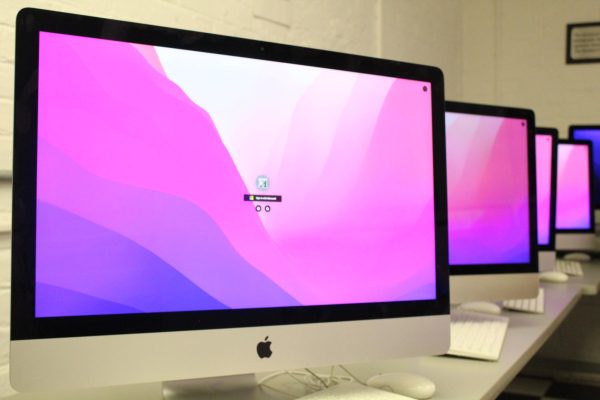In the past, a common view of the library or computer science labs consisted of tables, chairs, andiMac desktops. But now, the iMac desktops will disappear. Hackley has always implemented a Bring-Your-Own-Device (BYOD) program, and the majority of students do have their own capable devices. However, this does not mean that the iMac desktops were just stationary furniture; whether it be in the library, computer lab, or arts classes, these devices have proved themselves invaluable for word processing, visual arts and computer science.
That’s why it may confuse a portion of the Hackley community to learn that all iMac desktops will be removed in the near future. Towards the end of last year, the administration made the decision to remove all iMac Desktops in exchange for lending Macbook Airs to students who may need them – today, almost all iMacs in Hackley were removed, with the exception of those in the Photography Lab. Although these computers may be old, students still had access to advanced software as well as more processing power.
Why is Hackley removing these desktops, and how does this affect classes that relied on these computers? The answer lies in the different advantages of desktops and laptops.

These desktops, located in the photography lab, are some of the last few iMacs on campus. Since many of the schools’ iMacs have reached the end of their lifespan, they will be recycled to help other parts of the Hackley campus.
The iMac desktops offered quality monitors for graphic design and editing sessions; students and teachers alike could quickly but precisely assess their work due to the size of these computers. Furthermore, the computing power of these devices supersedes its laptop counterparts. However, Macbook Airs are easily transportable and more popular among the Hackley community. Since they are personalized for each individual, a Macbook Air could be much easier to navigate; it is versatile and improves communication. Do the advantages of Macbook Airs overtake the coming absence of iMac desktops?
“Sharing a bunch of Macbooks is not the same as sharing a bunch of desktops,” said Jessica Bottalico, an Upper/Middle School Visual Art Teacher. “Macbooks don’t have the same capacity to handle files or software as iMacs.”
Although personal devices and desktops can handle websites necessary for everyday classes, such as Google Documents, most Chromebooks and other devices are not compatible or struggle with advanced software. Photoshop and inDesign are applications needed for visual art classes, and some students may need to upgrade their personal devices. This decrease in capacity makes personal devices, unless they are newer versions, more prone to lagging.
Furthermore, due to the smaller screen size of Macbooks, art teachers must scrutinize different pieces of work more carefully, using the zoom tool to its fullest. With some teachers having to look at over 50 pieces of work, this can be grueling, or even wasteful, compared to the efficient process with iMac desktops.

Although Hackley cleared away most of the iMacs in the Upper School buildings, some of these computers remain in the Middle School buildings. These students are being taught under Dan Shaw, an Upper/Middle School Computer Science Teacher, while using the iMac desktops.
On one hand, this decision could be seen as poorly planned, where it negatively affects an array of classes. However, it may be irrational to believe that the removal of desktops was done for no explanation.
Robert Aldrich, the Director of Operations and Campus Planning, explains how this decision formed through a variety of reasons. One of these swivels towards the new Center for Creative Arts and Technology (CCAT).
When the administration planned for the new building over the last few years, “computer science classrooms were not designed to have permanent desktop computer stations,” said Mr. Aldrich. “All of the classrooms have movable furniture, and there is no permanent area where a bank of desktops could go.”
Furthermore, due to the old age of these desktops, they require an increasing amount of repairs, while some have even become inoperable. As the immovability of these desktops conflict against the CCAT’s design, combined with their detrimental age, these computers may be more of a burden than an advantage.
When asked about the detrimental effects of desktop removals on arts classes, Mr. Aldrich did not offer an opinion; however, Andy King, the Upper School Director at Hackley School, further explored the benefits of Macbooks and how the school body should perceive this change.
Mr. King also provided his thoughts on the desktops’ impact on the new Center. He re-emphasized how the structure and dynamic of the CCAT did not incorporate fixed stations for desktops.
Furthermore, he stated how “Hackley has always been a Bring-Your-Own-Device school,” where students are heavily encouraged and sometimes required to have their own computer. Advanced classes such as computer science require students to own personal devices which have all the functions needed for that class – students arguably should not need the desktops at Hackley. The removal of iMac desktops, coupled with the creation of the CCAT, is an opportunity to reignite the BYOD program to the student body. Although most personal devices, especially Macbooks, are less capable than its desktop counterparts, some classes may need to be “more flexible,” said Mr. King.
Advanced art classes will be negatively affected by this decision; however, it could be a necessary exchange for new, furnished rooms in the CCAT. As Hackley pushes forth into reinforcing policies and new dynamics, is this situation one where we let it unfold?





